

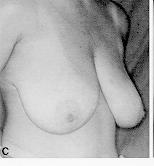
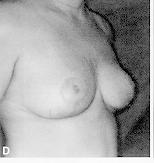
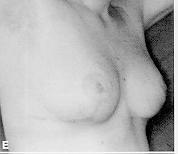
|
|
|
|
 |
 |
|
 |
 |
 |
|
|
|
|
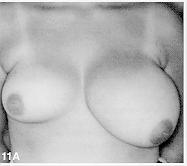 |
 |
|
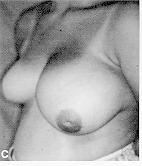 |
 |
 |
The main goal of this technique is to obtain better
longterm results. Natural shape and position are obtained in the majority
of cases. ln our opinion, leaving the inframammary fold untouched by placing
the scar above the sulcus, besides the gland's anatomic mound, represent
the main advantage of the procedure. This way, the inframammary fold is
preserved as a "natural ligament" responsible for the breast "hanging"
and its natural shape.
Lewis Jr. [2] showed the inverted-T scar
junction slightly above the inframammary sulcus. No further details exist
to clearly explain whether this specific position is representative of
a technique or is performed only in occasional cases.
All other necessary procedures to correct asymmetries
(breast cone mound, lateralizations, nipple-areola
distortions, etc.) are done routinely.
Another detail is related
to the cares taken to shorten the horizontal incision as much as possible,
but preserving the shape and the desired volume more than the incision
lengthening. Usually, patients complain more about the breast aesthetic
shape than about one or more centimeters of scar length.
As in any other type of aesthetic breast procedure,
advantages and disadvantages are present, mostly regarding bilateral positioning.
It has always been difficult to rebuild an unaesthetic breast into an aesthetic
one; it is even more difficult to make the opposite breast symmetrical.
Among the several approaches described here to help us reach the desired
symmetry. Even so, asymmetry within tolerable limits will always exist,
accepted by patients and doctors.
Conclusion
This technique was developed with the idea of placing the inverted T scar above the inframammary sulcus; associated with the anatomical mound and independent planes of sutures it achieves a good contour and natural shape.
References
| 1. | Georgiade NG, Serafin D, Riefkohl R, Georgiade GS: Is there a reduction mammaplasty for "all seasons?" Plast Reconstr Surg 63:765, 1979 |
| 2. | Lewis Jr JR: Atlas of Aesthetic Plastic Surgery. Boston: Little, Brown & Company, 1973, pp 226-227 |
| 3. | Pitanguy I: Une nouvelle technique de plastie mammaire. Étude de 245 cas consécutifs et présentation d'une technique personnelle. Ann Chir Plast 7:199, 1962 |
| 4. | Pontes R: A technique of reduction mammaplasty. Brit J Plast Surg 26:365, 1973 |